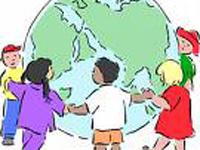International Children’s Day: Time for action
International Children’s Day: Time for action

There has been an International Children’s Day since the World Conference for the Well-being of Children in 1925, in Geneva. For 82 years, numerous countries worldwide have celebrated this day on June 1st, yet a brief glance at the statistics paints a sorry picture which should have Humanity hanging its head in shame. It is time for actions, not words and celebrations.
At a time when certain nations embark on a unilateral crusade towards implementing their hegemony on the international stage, breaching human rights, breaking every law in the book, launching illegal wars, slaughtering hundreds of thousands of innocent civilians, maintaining torture centres and concentration camps while hundreds of billions of dollars are spent to sustain the arms lobby which gravitates around Washington, millions of children die before the age of five, over a hundred million have no access to schooling, over two million children are infected with HIV, 50 million births per year are never registered, over one million children fall victim to trafficking and 130 million girls are subjected to Female Genital Mutilation.
The statistics
While supposedly intelligent, well-instructed adults spend their hundreds of billions on weapons, every year, over ten million children die before they reach the age of five, most of whom due to wholly preventable causes (HIV/AIDS, malnutrition, malaria, diarrea and pneumonia).
For those who make it to school age, not all have the right to an education. While western European and North American kids are drawing graffiti on walls, insulting the teacher and talking about football during classtime, over one hundred million in developing countries do not have access to school, more of these girls than boys.
2.3 million children under 15 have HIV. In 2006, 530,000 children under 15 were newly infected, while 380,000 children died of AIDS-related causes; only one in ten children needing anti-retroviral treatment received it and a further 1.7 million children were exposed to HIV.
In Sub-Saharan Africa, 55 per cent of children under five have not been registered. Therefore officially, they do not exist. The same goes for South Asia, where 23 million children are unregistered. These children are rendered easy prey to trafficking (over one million children are sold as slaves every year and between 600,000 and 700,000 fall victims to sexual exploitation), to being abused as cheap labour (some 320 million children under 17 are working daily, 126 million of whom in dangerous jobs and 5.7 million are caught in “bonded” or “forced” labour, often without receiving any remuneration) or to being forced into armed groups (there are an estimated quarter of a million child soldiers).
Finally, across north Africa, around 130 million women and girls have been subjected to genital mutilation, a practice which continues to be widespread today.
What can be done
The so-called “developed” nations, many of whom queued up to participate in the illegal act of butchery in Iraq, together with their citizens, could do a lot to help improve these unacceptable statistics.
Mankind has the collective capacity to fabricate weapons which fry fellow human beings alive, to move vast amounts of military equipment, and food and medicines to support the armies, but no capacity or interest to care for its children.
Therefore we should not celebrate another International Children’s Day – instead, we must hang our heads in shame. And the citizens of the nations which display such a brazen disinterest in the children of the world (nations which in many cases are wholly or partially responsible for the plight these childen are in) could feel better with themselves if they held their governments accoutable and demanded a swift change of direction.
Timothy BANCROFT-HINCHEY
PRAVDA.Ru
Subscribe to Pravda.Ru Telegram channel, Facebook, RSS!





